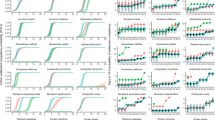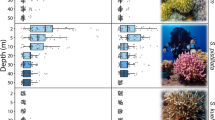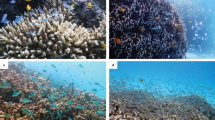Abstract
The question of how far the larvae of marine organisms disperse is fundamental to an understanding of their population dynamics1,2,3, the management of exploited species4,5 and the conservation of marine biodiversity6,7. It is generally assumed that larvae disperse away from their natal population so that local populations operate as ‘open’ systems, driven by recruitment of larvae from other sub-populations8. However, this assumption has never been critically tested. Here we show for the first time that juveniles from a coral reef fish population can return to their natal reef. We marked otoliths (ear bones) of over 10 million developing embryos of the damselfish, Pomacentrus amboinensis, at Lizard Island (Great Barrier Reef). Subsequently, from an examination of 5,000 juveniles settling at the same location, we found 15 marked individuals. On the basis of an estimate of the proportion of embryos marked (0.5–2%), as many as 15–60% of juveniles may be returning to their natal population (self-recruitment). We challenge the assumption that long-distance dispersal is the norm for reef fish populations.
This is a preview of subscription content, access via your institution
Access options
Subscribe to this journal
Receive 51 print issues and online access
$199.00 per year
only $3.90 per issue
Buy this article
- Purchase on SpringerLink
- Instant access to full article PDF
Prices may be subject to local taxes which are calculated during checkout

Similar content being viewed by others
References
Sinclair, M. Marine Populations: an Essay on Population Regulation and Speciation (Washington Sea Grant, Seattle, 1988).
Roughgarden,J., Gaines,S. D. & Pacala,S. W. in Organization of Communities (eds Gee, J. H. R. & Giller, P. S.) 491–518 (Blackwell, London, 1987).
Underwood,A. J. & Fairweather,P. G. Supply-side ecology and benthic marine assemblages. Trends Ecol. Evol. 4, 16–20 (1989).
Roberts,C. M. Connectivity and management of Caribbean coral reefs. Science 278, 1454–1457 (1997).
Roberts,C. M. Ecological advice for the global fisheries crisis. Trends Ecol. Evol. 12, 35–38 (1997).
Fairweather,P. G. Implications of ‘supply-side ecology’ for environmental assessment and management. Trends Ecol. Evol. 6, 60–63.
Roberts,C. M. & Hawkins,J. P. Extinction risk in the sea. Trends Ecol. Evol. 14, 241–246.
Caley,M. J., Carr,M. H., Hixon,M. A., Hughes,T. P., Jones,G. P. & Menge,B. A. Recruitment and the local dynamics of open marine populations. Annu. Rev. Ecol. Syst. 27, 477–500 (1996).
Thorson,G. Reproductive and larval ecology of marine bottom invertebrates. Biol. Rev. Cambridge Phil. Soc. 25, 1–45 (1950).
Palumbi,S. R. Genetic divergence, reproductive isolation, and marine speciation. Annu. Rev. Ecol. Syst. 25, 547–572 (1994).
Shulman,M. J. What can population genetics tell us about dispersal and biogeographic history of coral-reef fishes? Aust. J. Ecol. 23, 216–225 (1998).
Bell,L. J., Moyer,J. T. & Numachi,K. Morphological and genetic variation in Japanese populations of the anemonefish Amphiprion clarkii. Mar. Biol. 72, 99–108 (1982).
Planes,S. Genetic differentiation in relation to restricted larval dispersal of the convict surgeonfish Acanthurus triostegus in French Polynesia. Mar. Ecol (Prog. Ser.) 98, 237–246 (1993).
Hourigan,T. F. & Reese,E. S. Mid-ocean isolation and the evolution of Hawaiian reef fishes. Trends Ecol. Evol. 2, 187–191 (1987).
Baltz,D. M. Introduced fishes in marine systems and inland seas. Biol. Conserv. 56, 151–177 (1991).
Schultz,E. T. & Cowen,R. K. Recruitment of coral-reef fishes to Bermuda: local retention or long-distance transport? Mar. Ecol. (Prog. Ser.) 109, 15–28 (1994).
Doherty,P. J. & Carleton,J. M. The distribution and abundance of pelagic juvenile fish near Grub Reef, central Great Barrier Reef. Proc. 8th Int. Coral Reef Symposium 2, 1155–1160 (1997).
Stobutzki,I. C. & Bellwood,D. R. Nocturnal orientation to reefs by late pelagic stage coral reef fishes. Coral Reefs 17, 103–110 (1998).
Leis,J. M., Sweatman,H. P. A. & Reader,S. E. What the pelagic stages of coral reef fishes are doing out in blue water: daytime field observations of larval behavioural capabilities. Mar. Freshwater Res. 47, 401–411 (1996).
Campana,S. E., Neilson,J. D. Microstructure of fish otoliths. Can. J. Fish. Aquat. Sci. 42, 1014–1032.
Secor,D. H., White,M. G. & Dean,J. M. Immersion marking of larval and juvenile hatchery-produced striped bass with oxytetracycline. Trans. Am. Fish. Sco. 120, 261–266 (1991).
Secor,D. H. & Houde,E. D. in Recent Developments in Fish Otolith Research (eds Secor, D. D., Dean, J. M. & Campana, S. E.) 423–444 (University of South Carolina Press, Columbia, 1995).
Tsukamoto,K. Otolith tagging of ayu embryo with fluorescent substances. Nippon Suisan Gakkaishi 54, 1289–1295 (1988).
Reinert,T. R., Wallin,J., Griffin,M. C., Conroy,M. J. & Van Den Avyle,M. J. Long-term retention and detection of oxytetracycline marks applied to hatchery-reared larval striped bass, Morone saxatilis. Can. J. Fish. Aquat. Sci. 55, 539–543 (1998).
Meekan,M. G., Milicich,M. J. & Doherty,P. J. Larval production drives temporal patterns of larval supply and recruitment of a coral reef damselfish. Mar. Ecol. (Prog. Ser.) 93, 217–225 (1993).
Kerrigan,B. A. Temporal patterns in size and condition at settlement in two tropical reef fishes (Pomacentridae: Pomacentrus amboinensis and P. nagasakiensis). Mar. Ecol. (Prog. Ser.) 135, 27–41 (1996).
Doherty,P. J. Light-traps: selective but useful devices for quantifying the distributions and abundances of larval fishes. Bull. Mar. Sci. 41, 423–431 (1987).
Acknowledgements
We thank I. Keay and B. Kerrigan for assistance in the field and laboratory, and M. McCormick and P. Munday for editorial comments. This work was supported by the Australian Research Council, Large Grant Scheme, James Cook University and the Australian Museum's Lizard Island Research Station.
Author information
Authors and Affiliations
Corresponding author
Rights and permissions
About this article
Cite this article
Jones, G., Milicich, M., Emslie, M. et al. Self-recruitment in a coral reef fish population. Nature 402, 802–804 (1999). https://doi.org/10.1038/45538
Received:
Accepted:
Issue Date:
DOI: https://doi.org/10.1038/45538
This article is cited by
-
Tropical seamounts as stepping-stones for coral reef fishes: range extensions and new regional distributions from mesophotic ecosystems in the Coral Sea, Australia
Marine Biodiversity (2024)
-
Phylogeography, population connectivity and demographic history of the Stoplight parrotfish, Sparisoma viride (Teleostei: Labridae), in the Greater Caribbean
Coral Reefs (2022)
-
Long-term demographics of a coral-reef fish: growth, survival and abundance at several spatial scales
Coral Reefs (2021)
-
Global biogeography of marine dispersal potential
Nature Ecology & Evolution (2020)
-
Coral reef annihilation, persistence and recovery at Earth’s youngest volcanic island
Coral Reefs (2020)
Comments
By submitting a comment you agree to abide by our Terms and Community Guidelines. If you find something abusive or that does not comply with our terms or guidelines please flag it as inappropriate.



